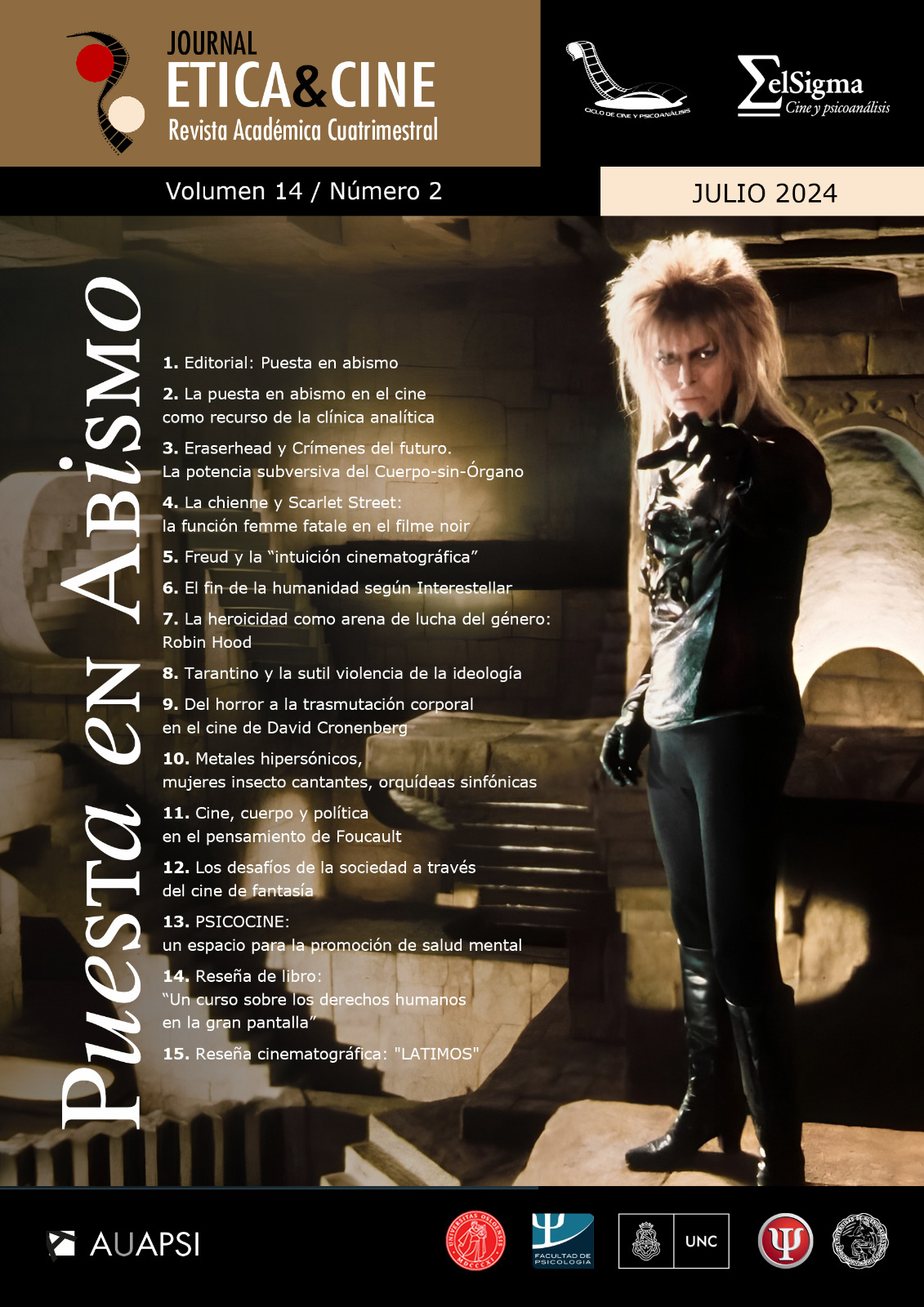From Horror to Body Transmutation in The Cinema of David Cronenberg
DOI:
https://doi.org/10.31056/2250.5415.v14.n2.45761Keywords:
Film industry, Film director, Corporality, TerrorAbstract
The presence of diseases, viruses, sex, violence and the fusion between flesh and inorganic matter have been the constant narratives of David Cronenberg’s cinema, creating a physical and psychological metamorphosis of the characters. These films present visceral imagery where the horrifying and macabre are present. Cronenberg explores the fears towards the body, the transgressions from inside-out, which materialize with technologies, which intrudes us into the dark labyrinths of the degradation of the anatomical mass mixed with metals and dirt. Cronenberg’s cinema, and perhaps its greatest virtue, is that it allows us to connect a critique to the condition of fragility of the biological body in the face of technoscientific advance, however, it also becomes a battlefield, that stage of the abject, from where binary oppositions are answered, and the vehicle to express all types of metaphorical, allegorical, metaphysical and abstract concepts, which dismantles all Cartesian dualist narrative. This last idea allows us to build a debate about a metamorphosis not only of the biological body, but also of the psychic one that the human species is going through; This being the main objective of this essay.
Downloads
References
Artaud, A. (1977). Van Gogh: el suicidado de la sociedad y para acabar de una vez con el juicio de dios. Fundamentos.
Berghaus, G. (2009). Futurism and the Technological Imagination. Editions Rodopi.
Blakesley, D. (1998). “Eviscerating David Cronenberg”, Enculturation. Vol. 2. No 1. 1-15. https://www.enculturation.net/2_1/blakesley/
Braidotti, R. (2015). Lo posthumano. Barcelona.
Burroughs, W. (2009). La revolución electrónica. Caja Negra.
Cabrejo, J. (2008). “Del mito de Orfeo a la película Videodrome: Cosmovisiones de la mujer y del descenso a los infiernos”. Tópicos del Seminario, No. 20, 129-153. https://www.redalyc.org/articulo.oa?id=59402006
Calabrese, O. (1999). La era neobarroca. Cátedra.
Deleuze, G, Guattari, F. (2010). Mil mesetas: Capitalismo y Esquizofrenia. Pre-Textos.
Díaz, L. (2015). “Las extensiones de los medios en el filme Videodrome de David Cronenberg”. http://www.henciclopedia.org.uy/autores/DiazBouquillard/Cronenberg.htm
De Lauretis T. (2012). “El cuerpo antisocial”. Pasajes: Revista de pensamiento contemporáneo, No. 37 (2012): 93-99, https://roderic.uv.es/handle/10550/46357
Duque, P, Sala, Á. (2022). “Patrones para una evolución somática en el cine fantástico contemporáneo”. En Navarro, A. La nueva carne una estética perversa del cuerpo. Valdemar.
Fernández, J. (2019). Políticas de la nueva carne: perversiones filosóficas en David Cronenberg. Holobionte.
Fisher M. (2013). Los fantasmas de mi vida. Caja Negra.
Foucault, M. (2007). Vigilar y castigar. Siglo XXI.
Gorostiza, J. (2016). Panorámicas urbanas 50 películas esenciales sobre la ciudad. Editorial UOC.
Gorostiza, J, Pèrez, A. (2003). David Cronenberg. Cátedra.
Haraway, D. (1995). Ciencia, cyborgs y mujeres: La reinvención de la naturaleza. Cátedra.
Hormigos, M. (2002). “Nuevas especies para el panteón de lo grotesco femenino. David Cronenberg y la Nueva Carne”. En: Antonio Navarro, La nueva carne, una estética perversa del cuerpo. Valdemar.
Ihde, D. (2004). Los cuerpos en la tecnología. Nuevas tecnologías: nuevas ideas acerca de nuestro cuerpo. Editorial UOC.
Imbert, G. (2019). Crisis de valores en el cine posmoderno. Cátedra.
Jameson, F. (1995). La estética geopolítica: cine y espacio en el sistema mundial. Paidos.
Keska, M. (2004). “El cine en la era neobarroca”, Revista internacional d’Art, No. 4, 271-278. https://raco.cat/index.php/Materia/article/view/83215/112148
Kuri, O. (2021). El cuerpo tecnificado en tres películas de David Cronenberg. Benemérita Universidad Autónoma de Puebla.
Laínez, J. (1997). “De la muerte como un simulacro: Carne, metal y ascetismo en Crash”. Banda aparte, No. 25-30. https://riunet.upv.es/handle/10251/42214
López, T. (2019). Cuerpos coagulantes: los procesos de transgresión corporal en el cine de David Cronenberg. Universidad Nacional Autónoma de México.
Marinetti, F. (2006). Critical Writings. Farrar, Straus and Giroux.
Navarro, A. (2005). La nueva carne. Una estética perversa del cuerpo. Valdemar.
Pedraza, Pilar. 2002. “Teratología y nueva carne”. En La Nueva Carne. Una Estética Perversa del Cuerpo, editado por Antonio José Navarro. Valdemar Intempestivas.
Rangel, S. (2015). Ensayos Imaginarios. Itaca.
Rodríguez, J. (2014). “David Croenenberg y el cuerpo abierto” Calle 14, No. 9 106- 117. https://doi.org/10.14483/udistrital.jour.c14.2014.2.a08
Rodley, C. (2000). David Cronenberg por David Cronenberg. Ediciones Alba.
Román, Ángel, 2004. Ensayos de la mirada. Madrid: Estudio Euroláser.
Sandonís, Á. (2019). “Cronenberg: las corrupciones de la carne”. Ventana Indiscreta No.21 54-61. https://doi.org/10.26439/vent.indiscreta2019.n021.4183.
Sibilia, P. (2014). “El cuerpo extraño: orgánico, demasiado Orgánico”. Interdisciplina 2, No. 3. 211-217. https://doi.org/10.22201/ceiich.24485705e.2014.3.47851
Sibilia, P. (2008). El hombre postorgánico. Fondo de Cultura Económica.
Sloterdijk, P. (2006). Normas para el parque humano. Siruela.
Telotte, J. (2002). El cine de ciencia ficción. Cambridge University Press.
Vidal, E. (2017). “David Cronenberg: videodrome y la posmodernidad”. Ventana Indiscreta, No. 06: 38,43. https://doi.org/10.26439/vent.indiscreta2011.n006.1090
Velasco, M. (2019). Larga vida a la nueva carne (El cuerpo en el cine de Cronenberg). Fundación Manuel Mindán.
Virilio, P. (2006). Velocidad y política. La Marca.
Williams, L. (1991). “Film Bodies: Gender, Genre, and Excess”. Film Quarterly, Vol. 44, No. 4, 602–16.
Downloads
Published
How to Cite
Issue
Section
License
Copyright (c) 2024 Ética y Cine Journal

This work is licensed under a Creative Commons Attribution-ShareAlike 4.0 International License.
Los autores que publiquen en Ética y Cine Journal aceptan las siguientes condiciones:
Los autores/as conservan los derechos de autor © y permiten la publicación a Ética y Cine Journal, bajo licencia CC BY-SA / Reconocimiento - Reconocimiento-CompartirIgual 4.0 Internacional. La adopción de esta licencia permite copiar, redistribuir, comunicar públicamente la obra, reconociendo los créditos de la misma, y construir sobre el material publicado, debiendo otorgar el crédito apropiado a través de un enlace a la licencia e indicando si se realizaron cambios.

Este obra está bajo una licencia de Creative Commons Reconocimiento-CompartirIgual 4.0 Internacional.




